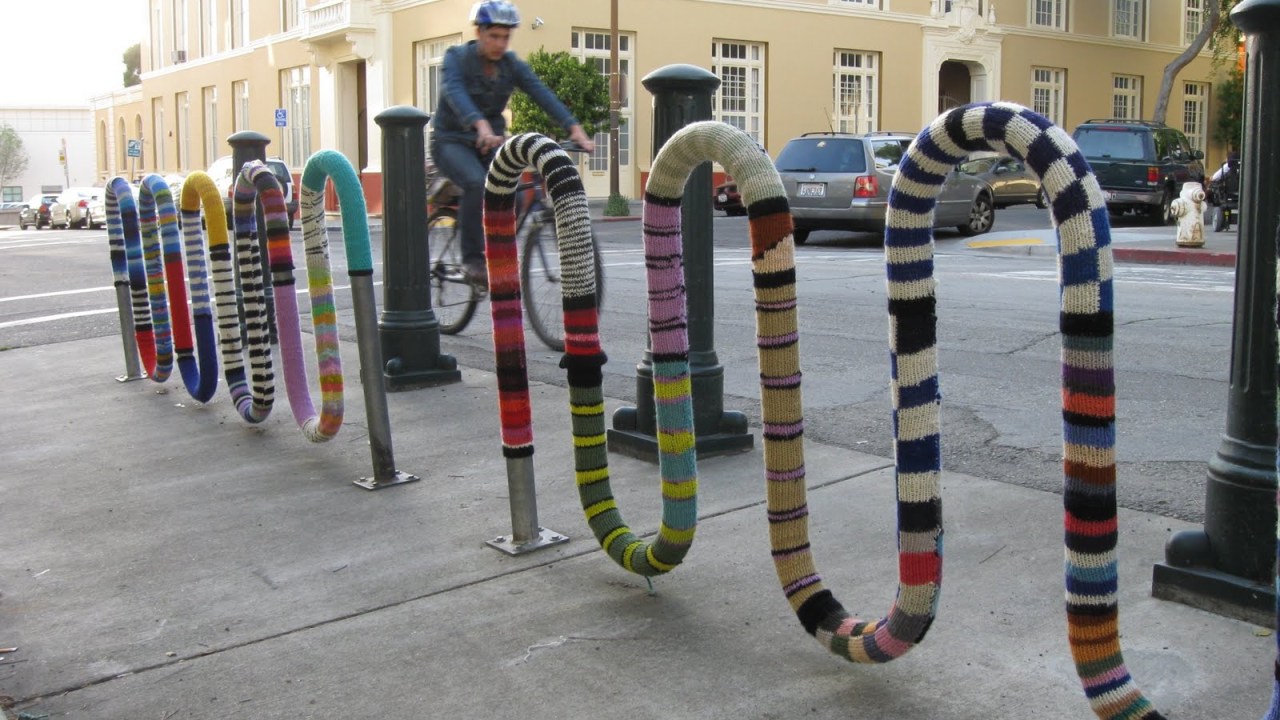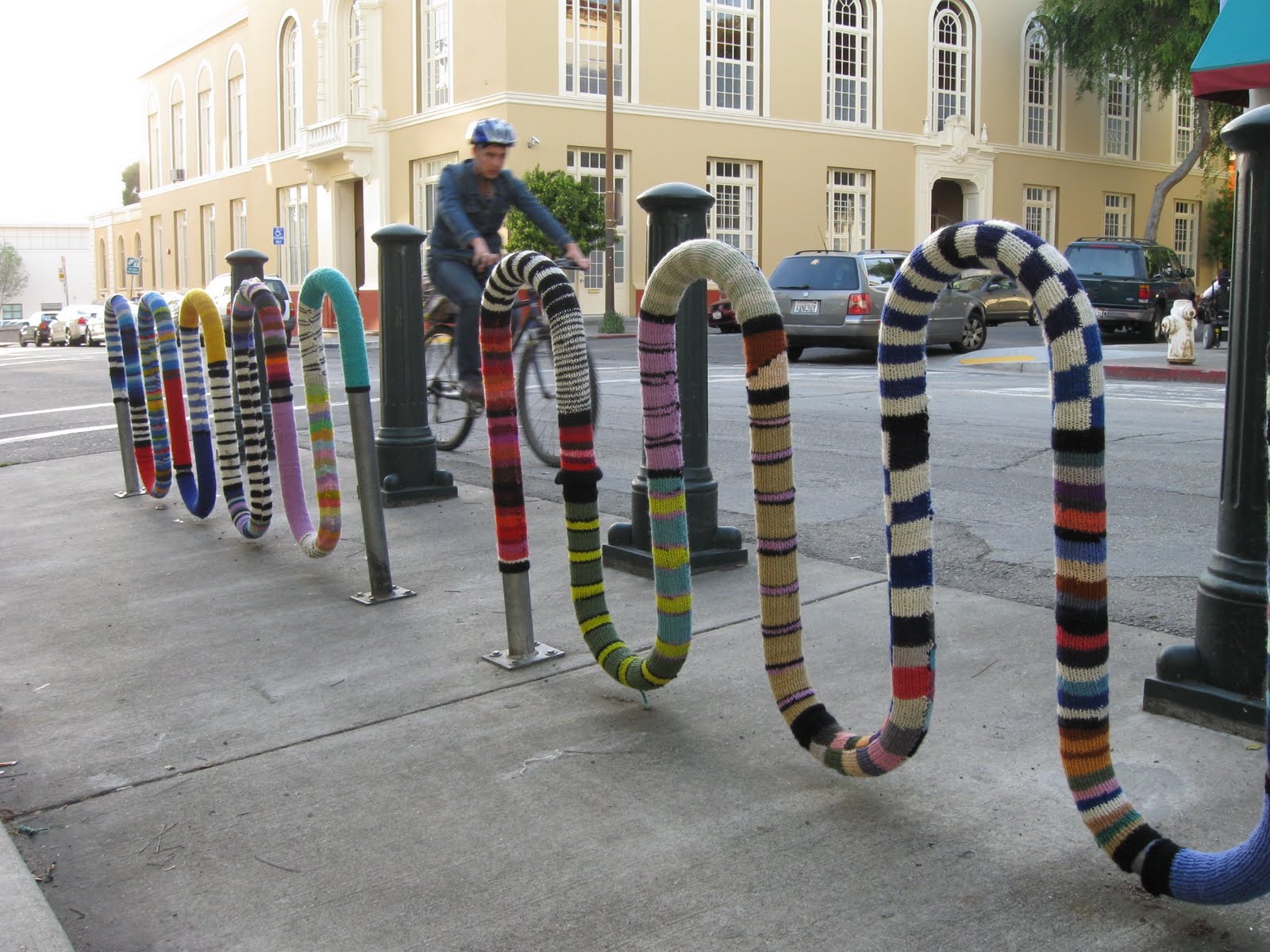
Over the past month we’ve hosted a conversation about the spectrum of control museums exert over audience input and participation. Barbara Stauffer from the National Museum of Natural History wrote of the challenges of inviting over 800 people to contribute to the community element of the Hyperbolic Crocheted Coral Reef. Maria Mortati described how the SF Mobile Museum solicits content and takes the resulting exhibits out into the community. And Streetcolor gave us an inside look into her yarnbombing, with which she contributes her own aesthetic commentary to museums. In this wrap-up these guest posters reflect on what they’ve learned from this exchange of perspectives.
Streetcolor:
Writing and reading for this project has changed my sense of what a museum can be. I realized that my ongoing yarnbombing is making the streets of Berkeley into a kind of museum. (See the photo of my latest Berkeley pieces-bike racks which are so delightfully sculptural even before I had to cover them in knitting.)
What struck me about Barbara’s story about the Crocheted Reef was how she thought NMNH wouldn’t have enough entries sent in and how they were flooded. I have always thought that most people would love to help, would love to do something good if they just knew how. Barbara’s project gave everyone an opportunity to make something meaningful and beautiful and big. Both the Reef and the SFM Mobile Museum projects took many small parts and made them into something complete and impressive. Can everyone participate in making the art in museums? Is a museum a permanent space? Can a museum be any space we declare to be a museum?
As we discuss museums I am going back to my base beliefs: people want to look at art, they want to make art, they want to have their own voice and they want to be part of something large and good. We all want the pleasure and happiness and insight that art brings. And of course we all want satisfying work. You all are true museum creators-I am more trying to change city streets and give people pleasure as they move in an ordinary day. And so we ease the world a little.
Maria:
I was surprised to see that Streetcolor made a play through her work with the museum through graphic mimicry of the architecture. Love that. I also was happy to see the sharing and re-posting the work. It warmed my heart that museums were engaging with it. I could see how that would be a tough balance for them to strike, so that’s cool.
What I found delightful from Barbara’s post was hearing about all the intellectual resources she had at hand to realize the exhibit. I really appreciated that she shared this element: “We also wanted to be sure our visitors would understand the exhibition in the context of our Museum, while allowing the installation to speak for itself”. In my experience, visitor contributed exhibits work best when they have been considerately designed or developed. For visitors it helps them get it, for the participants it values their contribution, and for the institution (large or small) it makes excellent use of their core competencies. Doing justice to the public’s contribution involves design and consideration in a flexible yet fully realized manner. So while Barbara has more resources at hand, I see this project as developing a new skill set for her institution.
In terms of next steps with the SF Mobile Museum, these posts have helped solidify my thinking around what they might be. The goal has always been to be a platform for experimentation. I’m thinking that I’d like to focus on pushing the envelope further and play with the structure of the “museum” vs. the topic or nature of the exhibits.
Barbara:
Reading about Maria and Streetcolor’s experiences makes me realize that we’re really all trying to do the same thing—surprise and engage communities—and that doing so requires similar tactics, whether it’s one individual or a large organization.
Their posts also remind me of how important it is to have one person dedicated to the project—particularly if you want to engage and remain responsive to a community. Even though Maria and Streetcolor have fewer resources behind what they are doing, they do have one huge advantage—they are completely dedicated to their projects. One disadvantage of a large organization like ours is that responsibilities are divvied up among any number of people, and everyone has a gazillion things on their plate at once. Having someone working on the reef full-time allowed us to actively engage the community rather than just launching a volley and waiting for it to be returned.
Has the Hyperbolic Crochet Coral Reef exhibit made NMNH looser in our methods for future exhibitions?Ironically, the exhibit has demonstrated the importance of greater planning and strategizing when it comes to future exhibitions. The museum is large and complicated and I don’t see the infrastructure diminishing.But, as a result of the HCCR project we now have a much better sense of what we need to do to plan for visitor participation – and we have statistics, final reports, and visitor feedback to help us make our case – both for the effectiveness of such projects but also for the need to funnel resources into them in order to make them work. Fundamental to that planning will be bringing in a dedicated community coordinator and strategic use of our social media vehicles.
Maria recommends readers check out:
An event that Machine Project put together at the Berkeley Art Museum, playing with lecturing and how far you can take it.
A fabulous informal series of gatherings at SFMOMA, loosely around the idea of survival for artists. It’s turned into a similar thread that the CFM blog explores: how can we not just survive and compete, but thrive?
The Open Space blog offer some wonderful food for thought as well.









